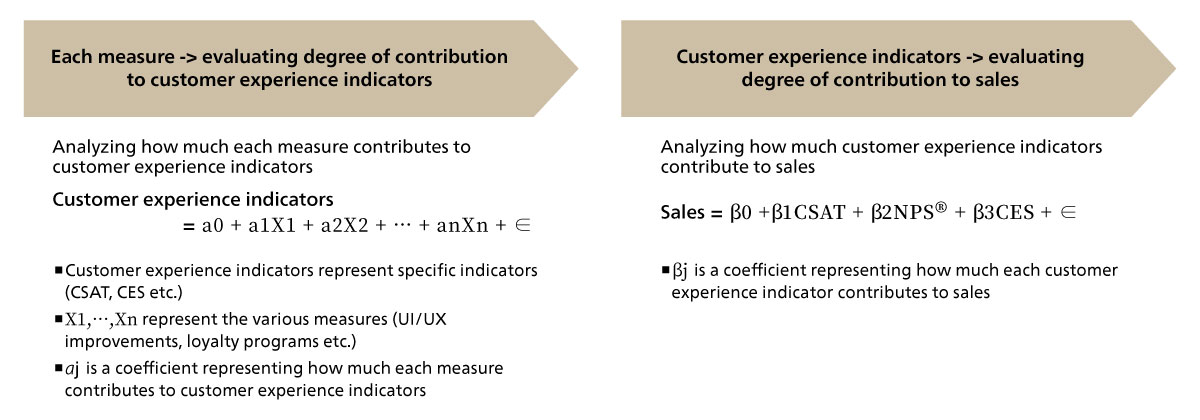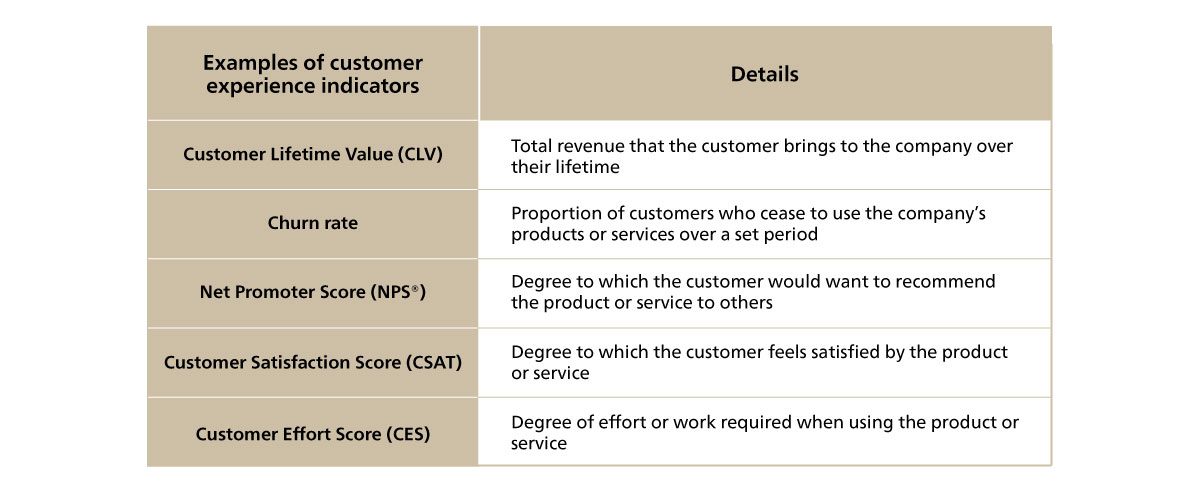Improving customer experience is critical for companies to build competitive advantage and grow sustainably. Even as all companies understand the importance of improving customer experience, we often hear leaders complain that initiatives to achieve this do not go as planned and that they are not seeing outcomes.
This Insight goes over our prescriptions for addressing the problems getting in the way of efforts to improve customer experience. While each company will face strategic and organizational problems that need individual solutions based on that company’s specific circumstances, in this article, we will be putting the focus on solving systemic problems that can, to a certain degree, be advanced across all companies, and on how to make progress on making an understanding of these measures permeate internally throughout companies, as well as presenting specific approaches for achieving this.
Accelerating Stalled Initiatives to Improve Customer Experience by Visualizing Investment Impact
- Data-Driven Management
- Marketing, Sales, and Customer Service

Three Problems Getting in the Way of Efforts to Improve Customer Experience
For companies to achieve growth in today’s Japan, which is going through a period of declining population, they need to either launch new businesses aimed at developing new markets, or they need to differentiate themselves from their competitors by improving the customer experience in order to gain market share. We covered launching new businesses in a previous Insight*, so in this Insight we will look at efforts to improve customer experience.
*ABeam Consulting, “What Separates Success and Failure in New Businesses as Seen in our ’Survey of New Business Initiatives’” (2024)
The Importance of Efforts to Improve Customer Experience
When we talk about a company’s marketing activities, we tend to think of things like promotions and digital marketing, but in today’s world those things alone are not enough. A survey of consumers by Qualtrics* suggests that companies stand to lose 7% of sales if customers have even just one unsatisfactory or poor experience, such as delayed delivery or difficulty getting through to a call center. For this reason, in today’s world, efforts to improve customer experience at every possible point of contact can be said to form part of a company’s marketing or branding.
What will become of companies if they make no efforts to improve customer experience? The impacts will not be limited to temporary losses of customers or damage to the brand. Companies can start to become dependent on price competition as they experience lowered customer value or competitive power, and run the risk of not only experiencing deteriorating revenues, but also seeing lowered motivation among employees, increased employee turnover, and a weakening of their organizations, as employees on the ground have their hands full dealing with dissatisfied customers and complaints. For this reason, we can also see efforts to improve customer experience as more than just an aspect of marketing or branding, with it forming part of a company’s sustainable growth.
*Qualtrics Japan LLC, “Global consumer trends for 2025 revealed” (2024)
Three Problems Getting in the Way of Efforts to Improve Customer Experience
In my own experience speaking to companies across a variety of industries, many companies are aware of the importance of efforts to improve the customer experience. But why, with the exception of a few leading companies, do these efforts tend not to go according to plan, or to produce the expected outcomes? I want to address three key problems that come up here.
① The Problem of Strategy
In many cases, the positioning or priority of efforts to improve customer experience amidst the many initiatives that form part of managing a company can become ambiguous. In such cases, if temporary fiscal pressures become severe, we often see companies engage in ad hoc responses such as concentrating resources in immediate measures to increase sales or reduce costs, lowering the priority of initiatives to improve customer experience.
Even when efforts to improve customer experience do manage to be a priority, ambiguity in goals and targets can often lead to cases where progress is scattershot because there is no shared direction among all team members, or cases where companies fail to engage in efforts that have value for customers, due to a lack of customer understanding.
② Organizational Problems
Initiatives to improve customer experience often span multiple departments. It can be difficult to try to improve customer experience, however, while maintaining consistency throughout the process, if there is a lack of operational or informational coordination across departments.
If budgets are managed on a per department basis, there can also be cases where budget is not distributed adequately across departments for efforts to improve customer experience to succeed.
③ Systemic (Processes and Systems) Problems
There are many companies that are forced to minimize the resources in terms of budget and personnel that they dedicate to improving customer experience, because they cannot clearly ascertain the effects on sales and profit that investment in such efforts will bring.
The cause of this lies in inadequate frameworks of processes and system platforms for measuring impact, such as in cases where indicators for measuring impact to determine the status or outcomes of improvements to customer experience are unclear, or cases where, even if the indicators have been clarified, companies are failing to properly analyze the data.
For example, many companies that have introduced NPS® (Net Promoter Score) as an indicator to measure customer loyalty (trust or attachment) are dissatisfied with the system, but in using this indicator, companies need to refer to it with a proper understanding of its nature. Culturally speaking, Japanese customers tend to take recommending products and services to others very seriously, and so tend avoid influencing the choices of others, so NPS® tends to result in lower likeliness to recommend. Japanese customers also tend to assign middle scores when they rate things, so NPS® tends to be lower. For this reason, when measuring the outcomes of improvements to customer experience in Japan, there is a risk that just relying on NPS® will not lead to an appropriate evaluation, so companies may be better off considering a combination of multiple indicators such as Customer Satisfaction Score (CSAT).
Our Prescriptions for Advancing Efforts to Improve Customer Experience
To resolve strategic and organizational problems getting in the way of improving customer experience, companies may need to clarify how they position improving customer experience within their overall corporate strategies, and form cross-departmental teams to drive initiatives company wide. While many companies do, in fact, do this, in practice, the reason that this can fail to lead to expected outcomes is often that they fall into the trap of engaging in superficial measures, because they have failed to adequately foster commitment among their leadership layer and a customer-centered organizational culture.
So what do companies need in order to engage in genuine measures? As Figure 1 illustrates, it is important for companies to set targets for their initiatives to improve customer experience using a SMART (“Specific, Measurable, Achievable, Relevant, Time-bound”) framework, and address systemic problems so that these targets are connected to management indicators such as sales, before they move forward with addressing strategic and organizational problems. Companies then also need to make an understanding of these targets permeate internally throughout their organizations, including among the leadership layer, while demonstrating outcomes and progress against those targets.
The external and internal environments of each company will also differ in ways that make it impossible to address strategic and organizational problems by just following an undifferentiated methodology, or case studies from other companies, so order-made approaches specific to each company are essential. This Insight will therefore focus on solving systemic problems that can, to a certain extent, be advanced across companies, and on ways to make understanding of the process permeate internally throughout companies.
 Figure 1. How to make progress on solving problems
Figure 1. How to make progress on solving problems
How to Solve Systemic Problems and Help Understanding Permeate Internally Throughout the Company
Step 1. Visualizing the investment impact of improving customer experience
Firstly, companies need to confirm how much they are currently investing in efforts to improve customer experience. Beginning with the costs associated with introducing new technologies and promotions, these costs can span the range from development costs related to improvement measures to the operational costs of sustaining measures, the personnel costs associated with training employees and the costs of external resources. However, to maintain objectivity, it is important to extract these costs without letting anything slip through.
At the same time, many companies are likely to find it easier to understand an approach to showing impact, as illustrated in Figure 2, in which we make a tiered evaluation of how much each measure is contributing to improving customer experience and how much improving customer experience is contributing to sales.
 Figure 2. Approaches to visualizing impacts on improving customer service
Figure 2. Approaches to visualizing impacts on improving customer service
In performing such an evaluation, we calculate impact using multiple regression in combination with customer experience indicators, as illustrated in Figure 3. However, customer experience indicators need to be added and contribution coefficients adjusted according to industry or the products and services that a company deals in.
 Figure 3. Examples of customer experience indicators
Figure 3. Examples of customer experience indicators
Step 2. Promoting internal understanding by generating continuous impact
To promote understanding of the importance of improving customer experience, it is important for companies to keep an eye on the state of each customer experience indicator, make continuous improvements in response to evaluations, and share progress and outcomes with the entire company, including the leadership layer.
And while the effects brought about by efforts to improve customer experience are often long term, companies may be able to accelerate how quickly they can put changes to strategy and organizations into action if they can create smaller successful case studies, and use those to prove that investment into efforts to improve customer experience can bring about short-term profit.
Summary
In recent times, many companies have done rounds of investment into building digital marketing platforms. Today, they are focusing their efforts on redeploying their advertising budgets or seeking to streamline marketing operations in response to rising digital advertising costs. While some companies may be inclined to focus solely on streamlining efforts to increase investment efficiency in the short term, companies should continue to drive efforts to improve customer experience so that they can build competitive advantage enabling sustainable growth.
This Insight presented quantifying and visualizing investment impact as a solution for how companies can continuously drive efforts to improve customer experience. We caution companies to be aware that, if they move forward with such quantification and visualizing efforts, they cannot achieve by just relying on undifferentiated methodologies, but, instead, need to adopt individualized approaches according to their industry or products and services.
They also need to engage in continuous improvement and visualize the outcomes of these processes in order to make understanding of these efforts permeate internally throughout their organizations. At ABeam Consulting, we have the systems in place to offer clients side-by-side support to efficiently advance and improve efforts to quantify and visualize the investment impact of initiatives to improve customer experience in ways that are industry and company-specific, based on our track record of supporting companies across industries in their efforts to improve customer experience, and the know-how that comes from that. If you are thinking about accelerating efforts to improve customer experience at your company, please consider doing so with our support.
Click here for inquiries and consultations

